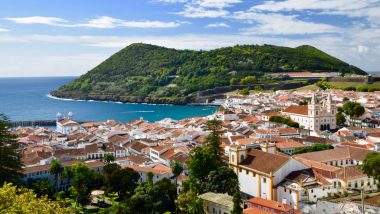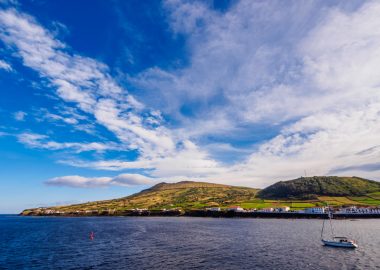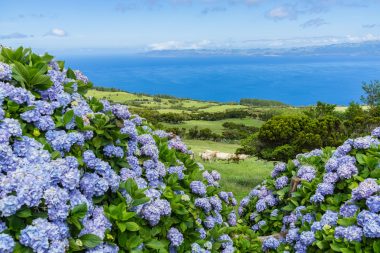The Azores are a group of islands belonging to Portugal , located in the Atlantic Ocean, just under a two-hour flight from the Portuguese mainland. Pleasant climate, many water sports facilities and wonderful nature make the archipelago a special holiday destination. It stretches over a length of about 500 km and is divided into three groups – northwestern, central and southeastern group.
Each island has its own distinctive character and is worth a trip. Decide for yourself which of the nine islands will be your new favorite island.
São Miguel

São Miguel is the largest island in the Azores with a length of over 60 km and a width of 16 km and, together with Santa Maria, belongs to the southeastern group. It also has the most inhabitants with about 140,000 inhabitants. The island’s capital, Ponta Delgada, is also the capital of the Azores. The historic old town is particularly appealing with its narrow streets and typical Portuguese paved mosaics. It attracts with numerous shopping opportunities and the many restaurants and cafés invite you to linger and enjoy. With about 250 hours of sunshine a month, São Miguel is not only ahead in terms of weather. It is also the leader of the islands in terms of the number of tourists and overnight stays. This popularity is primarily due to the versatility of the island, as São Miguel combines the advantages of several islands in the archipelago. Untouched nature on the one hand and lively entertainment on the other are good conditions to spend a wonderful and unforgettable holiday. The healing springs and the fine sandy beaches make São Miguel a popular spa and bathing resort. Particularly worth seeing are the extinct volcanic craters, in which dreamlike lake landscapes have formed, as well as lava caves and hot springs.
Santa Maria
With a length of almost 17 km and a width of 8 km, Santa Maria is one of the smallest, but it is the oldest and southernmost island of the Azores. The climate here is quite rainless and mild, because the sun spoils the less than 6,000 inhabitants of the island with many hours of sunshine. The bays and beaches with the finest white sand, such as in Praia Formosa and São Lourenço, invite you to linger and relax. The beautiful weather and the beautiful sandy beaches make Santa Maria quite popular with holidaymakers despite its small size. Thus, the island convinces with a good infrastructure such as a developed road network and a regular flight connection to the Portuguese mainland. Various events such as the annual music festival Mare de Agosto also provide good entertainment for island guests. The many small villages and churches of the island are worth a visit, as are the handicrafts and pottery, which are traditionally made and are an extraordinary memory of an impressive holiday.
Terceira

Terceira belongs to the central group with the sister islands Graciosa, São Jorge, Pico and Faial . With about 56,000 inhabitants, a length of 29 km and a width of almost 18 km, it is the third largest island in the archipelago in terms of area and has the most inhabitants after São Miguel. The island’s capital, Angra do Heroísmo, is both the oldest city and the only World Heritage Site in the Azores. After a severe earthquake destroyed large parts of the village in 1980, it was restored with a lot of effort. The lovingly and brightly painted houses in the well-kept streets of the city convey an incredibly great atmosphere that no visitor should miss. Just as worth seeing is Monte Brasil, which, as an extinct volcano, offers a wonderful view over the Terceira landscape and is therefore a popular hiking destination. The stalactite cave Algar do Carvão in the heart of the island or the wine museum in Biscoitos are also worth a visit. Viticulture, agriculture and livestock farming make up the main source of income, along with tourism, and at the same time provide Terceira’s unique character. But even those who want to swim and relax by the water have a wide choice. Since the island consists of lava rock, there are many seawater pools in addition to individual sandy beaches, which allow natural but safe bathing.
Graciosa

Graciosa is the second smallest island in the Azores archipelago with only 5,000 inhabitants and a size of almost 13 km long and 7 km wide. As a result, it is less developed for tourism, but still has a lot to offer, so that it could be described as a real insider tip. Especially those who are looking for peace and relaxation will spend a successful holiday here. Graciosa is visually characterized by rustic windmills, many small hills and large, lush green meadows with countless cows. The villages have their very own charm and, like the entire island, radiate an idyllic tranquility. At the Carapacho Thermal Baths, the warm waters provide relaxation and the sea pools are also a wonderful alternative to swimming on the beach.
But the urge for adventure and discovery is also satisfied on Graciosa. The lava cave Furna do Enxofre with the sulfur grotto is impressive by its size alone and an absolute attraction on the island.
São Jorge
São Jorge has about 9,000 inhabitants and is quite long and narrow with a length of almost 54 km and a width of 7 km. Due to its large pastures and the predominance of milk and cheese production, it is also known as the “island of cheese” and the “greenest island in the Azores”. A visit to a cheese dairy and tasting of the spicy specialties is therefore an essential part of a trip to the island. São Jorge is not an island for a classic beach holiday due to its many cliffs. However, the so-called fajãs, the narrow coastal strips, and the sea swimming pools still provide sufficient bathing pleasure. Surfers and other water sports enthusiasts in particular get their money’s worth here. São Jorge also has a lot to offer for active holidaymakers. The beautiful landscape invites you to hike or cycle and the mountain ridge with its over 1,000 meters of altitude rewards you with a great view. Of course, the villages of the island are also worth seeing. The main town of Velas is particularly inviting with its pedestrian zone, the city park, the marina and the small shops and cafés.
Pico

Pico is the second largest island in the Azores in terms of area, but has just under 14,000 inhabitants. The volcano of the same name is even the highest mountain in Portugal at 2,351 m and is worth a visit despite the arduous ascent. The view to the neighboring islands is simply indescribable and quickly makes you forget the effort. The highlands with the lush vegetation, the volcanic lakes and caves are also unique and inspire not only pronounced nature lovers. Often the landscape of the island still seems as original and untouched as it did many years ago. Whaling, which was an important source of income for the islanders until the 1980s, is now only told by the museum. Instead, trips are offered on which different whale species can be observed and impressively photographed. Since the current of the Atlantic is quite strong here, the various sea swimming facilities should be preferred for swimming. If you want to relax after an active day, you can taste the excellent wines and typical cheese of Pico or simply end the day wonderfully in one of the small restaurants.
Faial

With a length of 21 km and a width of 14 km, Faial is one of the medium-sized islands of the Azores. Almost half of the island’s approximately 14,500 inhabitants live in the island’s capital Horta. At the same time, it is a popular port of call for sailors who want to cross the Atlantic. Praia do Porto Pim, the fine sandy beach in the sheltered bay, as well as the old whale factory, which now houses a museum, also invite you to the city and make for a fun or relaxing day. The partly baroque facades of the churches and other buildings are also quite impressive and make Horta a city worth seeing. At least as attractive are the countless, deep blue hydrangea bushes that grow all over the island and have earned it the nickname “Ilha Azul”, the blue island. The rest of the nature and landscape on Faial, as with the other islands of the archipelago, is of volcanic origin and therefore quite impressive.
Flores

The two islands of the northwestern group are Flores and Corvo. This is where most of the rainfall of the Azores falls, which in turn is reflected in the biodiversity of the flora and fauna. Flores is the westernmost point of Europe, with just under 3,700 inhabitants the second smallest island and also one of the smaller Azores islands in terms of area. However, its name, Flores means flowers, suggests that the island must be particularly beautiful. In summer, the hydrangeas bloom in the most beautiful shades of blue and also in spring and autumn colourful flowers can be seen everywhere, giving the island its unique character. The many lakes and forests, impressive waterfalls and fantastic stretches of coastline also make hikers rave. Tourism is an important source of income for Flores in addition to agriculture, which means that the infrastructure is quite good overall and makes the island stay very pleasant. Nevertheless, the island does not seem overcrowded, so that nothing stands in the way of both an active and a relaxing holiday.
Corvo
Corvo is the smallest Azores island with less than 500 inhabitants, 6 km long and 4 km wide. It is home to only one place, Vila do Corvo, which is one of the smallest cities in Europe. Despite this small size, there is an airfield and various accommodation options. Corvo also has a small sandy beach and a large natural swimming pool. Thus, the small island is not only worth seeing for tourists who take a day trip from the other Azores islands. Corvo was once formed from the extinct volcano Monte Gordo. The crater, which is still visible, has a remarkable diameter of 3.5 km, making it almost as wide as the island itself. The view from the crater rim of the lakes and islands in the volcanic crater is breathtaking and unforgettable – for this alone a visit to the small island is worthwhile.




